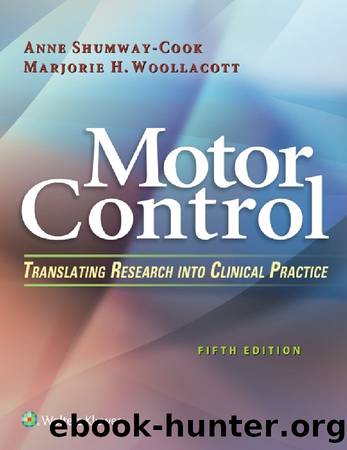Motor Control: Translating Research into Clinical Practice by Anne Shumway-Cook & Marjorie H. Woollacott

Author:Anne Shumway-Cook & Marjorie H. Woollacott [Shumway-Cook, Anne]
Language: eng
Format: azw3
Publisher: LWW
Published: 2016-02-14T16:00:00+00:00
Characterizing the Development of Steady-State Gait: EMG and Kinematics
Other researchers (Forssberg, 1985; Okamoto et al., 2001) have examined in more detail the contribution of the nervous system to the emergence of locomotion. Forssberg (1985) postulated that human locomotion is characterized by the interaction of many systems with certain hierarchical components. His research suggests that an innate pattern generator creates the basic rhythm of the step cycle, which can be seen in newborn stepping. In the first year, the gradual development of descending systems from higher neural centers gives the child the ability to control this locomotor activity. Systems for posture or equilibrium control, organized at a higher level than those controlling the pattern generator, develop over a longer period.
According to this research, the emergence of walking with support is not the result of critical changes in the stepping pattern per se but appears to be due to maturation of the postural control system. In addition, the gradual emergence of mature gait over the next year is hypothesized to result from a new higher-level control system influencing the original lower-level network and modifying it (Forssberg, 1985).
Forssberg's research, using electromyography (EMG) and motion analysis, has examined how the locomotor pattern changes over the first 2 years of development. Studies using motion analysis techniques have shown a gradual transformation of the locomotor movement from a synchronous pattern of joint movements in newborn stepping to a more adult-like pattern of joint motion by the end of the first year of development. The transformation to adult-like gait patterns happens during the latter part of the second year. At this point, heel strike begins to occur in front of the body. Figure 13.2 shows the kinematics of neonatal versus adult stepping movements. Note that the infant shows high levels of hip flexion as compared with the adult.
Download
This site does not store any files on its server. We only index and link to content provided by other sites. Please contact the content providers to delete copyright contents if any and email us, we'll remove relevant links or contents immediately.
Periodization Training for Sports by Tudor Bompa(8210)
Why We Sleep: Unlocking the Power of Sleep and Dreams by Matthew Walker(6654)
Paper Towns by Green John(5136)
The Immortal Life of Henrietta Lacks by Rebecca Skloot(4548)
The Sports Rules Book by Human Kinetics(4342)
Dynamic Alignment Through Imagery by Eric Franklin(4176)
ACSM's Complete Guide to Fitness & Health by ACSM(4019)
Kaplan MCAT Organic Chemistry Review: Created for MCAT 2015 (Kaplan Test Prep) by Kaplan(3970)
Introduction to Kinesiology by Shirl J. Hoffman(3743)
Livewired by David Eagleman(3729)
The Death of the Heart by Elizabeth Bowen(3578)
The River of Consciousness by Oliver Sacks(3572)
Alchemy and Alchemists by C. J. S. Thompson(3481)
Bad Pharma by Ben Goldacre(3396)
Descartes' Error by Antonio Damasio(3247)
The Emperor of All Maladies: A Biography of Cancer by Siddhartha Mukherjee(3112)
The Gene: An Intimate History by Siddhartha Mukherjee(3074)
The Fate of Rome: Climate, Disease, and the End of an Empire (The Princeton History of the Ancient World) by Kyle Harper(3030)
Kaplan MCAT Behavioral Sciences Review: Created for MCAT 2015 (Kaplan Test Prep) by Kaplan(2957)
